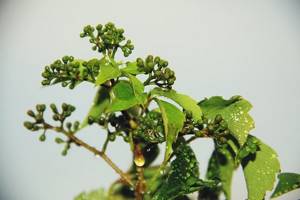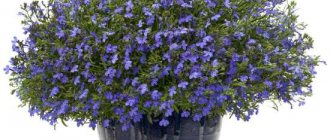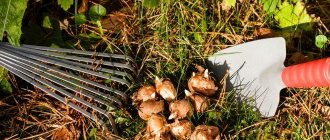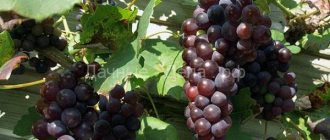Wild grape is a large, fast-growing and incredibly hardy perennial vine. The appearance of the gorgeous foliage that spectacularly turns red at the end of the season is well known to everyone, because wild grapes are the most popular plant used in urban landscaping to decorate buildings.
In private gardens, this crop can be found less often and this is due to the concerns of many gardeners. Since wild grapes are found to be an overly aggressive and completely uncontrolled plant, which, in addition, contributes to the spread of mice and pests throughout the area and home. But such a reputation is completely unfair... in fact, everything is different.
Planting, growing and propagating virgin grapes
Maiden grapes are propagated by seeds, green or lignified cuttings and layering. At the same time, the culture is completely unpretentious and undemanding in terms of acidity, density and soil fertility (although it will prefer fertile and permeable ones in case of choice).
It is enough to plant the seedling in the ground, once adding humus with any complex fertilizer to the planting hole, and water it abundantly. Then the maiden grapes will independently, with the help of adventitious roots, spread over the structure or support (growth rate is 1-3 m per year!) and cover it with a carpet of beautiful openwork leaves.
In the first year of development, the vine still needs abundant watering, and in subsequent years it requires almost no care. Maiden grapes grow well both in the sun and in partial shade, tolerate urban air pollution well, and can withstand even the harshest winters without shelter. The only thing you will need to do is to annually direct the shoots of the plant in the right direction and trim off the excess lashes that protrude beyond the limits you have envisaged. The length of the vine varies depending on the species, but some plants exceed 7-10 meters!
The plant is practically not afraid of pests and diseases if you do not over-moisten the soil and do not allow it to dry out too much.
In July, small cream flowers appear on the virgin grape vine, emitting a pleasant aroma. In September, in their place, medium-sized (up to 1 cm in diameter) dark blue fruits, collected in clusters, ripen.
Care
Wild grapes are an unpretentious plant, and caring for them consists of periodic watering, loosening the soil, fertilizing and pruning. For young plants, be sure to provide support and guide their growth. When the antennae become stronger, they will independently cling to the rough surface.
Don't forget to water the grapes, especially during hot periods. It is recommended to moisten the plant 3-4 times per season. But in dry weather, watering should be increased. Each bush requires 10 liters of water. Be sure to loosen the soil during irrigation or rainfall. This will ensure air access to the roots. After this procedure, it is advisable to mulch the tree trunk circle with compost or peat.
In late spring - early summer, add nitroammophosphate to the water for irrigation, at the rate of 40-50 g per square meter. In the middle of the season, feed the crop with complex mineral fertilizer. Kemira Universal is suitable for these purposes. In the fall, apply potassium fertilizers, for example, “Kalimagnesia” or ordinary stove ash.
Popular decorative varieties of virgin grapes
The variety of types of maiden grapes with palmate, ovate or oblong leaves allows you to create a variety of compositions on the site.
Of the main types of parthenocissus, landscape designers give preference to the North American five-leaved (Virginian) and attached virgin grapes, as well as the Asian triacid (ivy). Currently, there are many ornamental varieties and garden forms with variegated, brighter foliage of various colors, pubescent shoots, elongated inflorescences, and brighter autumn coloring occurs in sunny places.
Let's consider some of the varieties and types of virgin grapes, the most popular among landscape designers and simple summer residents.
How to plant wild grapes
The answer to the question of how to plant maiden grapes is clear: growing maiden grapes on your plot is quite easy! The plant is absolutely unpretentious. If you want to grow a strong, beautiful plant, you need to choose the right place. For those who like to do everything in detail in order:
- dig a hole for a cutting of the required size;
- mix the soil with sand and compost, add fertilizer (two handfuls);
- lay the bottom of the hole with drainage (crushed stone, broken brick or coarse sand);
- pour soil mixture on top;
- place the cutting in the hole at a slight angle;
- cover the seedling with soil mixture;
- form an irrigation hole to retain precipitation in it;
- water the sprout well;
- a small plant can be tied with wire or a support can be made for it.
Troki (Troki, Red Wall)
A variety of five-leaf girlish grapes of Polish selection.
Deciduous. The lashes reach 10-20 m in length. It grows quickly, the annual growth is 1-2 m.
Grows on any soil, unpretentious. Shade-tolerant, drought-resistant, frost-resistant. Once a year it is necessary to carry out anti-aging pruning.
It is distinguished by large, shiny, alternately serrated leaves, bright green in summer and fiery purple in autumn.
It blooms in June and produces blue-black decorative fruits and berries.
Frost resistance zones 4-9.
Used as ground cover and for vertical gardening, it feels great as a container plant.
Description
This perennial plant is popularly known as virgin grape or virgin ivy. This nickname stuck due to the plant’s ability to pollinate itself, thanks to the presence of bisexual flowers.
Decorative foliage is especially attractive. The bright green summer color gives way in autumn to purple, red and even purple.
Small clusters ripen in early autumn. As they ripen, the small round berries acquire a dark blue, almost black hue with a waxy coating. They are not edible, but they contrast beautifully with the purple foliage.
The bushes have good growth vigor and easily adapt to environmental conditions. The culture is cold-resistant and can withstand frost and winter even when uncovered. The grapes perform well in conditions of elevated temperatures and drought.
Engelmannii (Engelmannii)
Garden form of five-leaf maiden grape.
Deciduous. The lashes reach 10-15 m in length. It grows quickly, the annual growth is 0.5-1.2 m.
Grows on any soil, unpretentious. Shade-tolerant, frost-resistant, moisture-loving. Once a year it is necessary to carry out anti-aging pruning.
It is distinguished by alternately arranged pointed toothed leaves (longer and smaller than the original form) on long reddish petioles, bluish-green in summer and dark carmine-purple in autumn.
It blooms in July-August, produces blue-black decorative fruits and berries with a bluish bloom.
Frost resistance zones 4-8.
Used as ground cover and for vertical gardening, it feels great as a container plant.
Propagation by cuttings
This propagation method is simple and even an inexperienced gardener can handle it. Moreover, the event can be held in spring, summer and autumn. In addition, the cuttings are planted immediately in a permanent place, which greatly simplifies the matter. After all, you don’t need to bother with seedlings and subsequent transplantation.
For rooting, choose strong, woody shoots as thick as a pencil. Cut them into cuttings 25–30 cm long. Make sure that each of them has 3-5 healthy green buds. To ensure that the cuttings take root, prepare the soil before planting. To do this, mix humus, turf soil and sand in equal parts.
Plant the branches in holes 7–10 cm deep. Make sure that there are at least two buds below the surface of the soil. And the rest were located above the ground. At first, provide the cuttings with gentle care. To do this, water the planting regularly, especially in hot weather, and cover the cuttings from the scorching rays of the sun.

Murorum (Murorum)
A variety of five-leaf girlish grapes.
Deciduous. The lashes are very dense, reaching 8-10 m in length. It grows quickly, the annual growth is 0.5-1.2 m (at a young age it grows slowly, then the growth rate increases).
Grows on any soil, unpretentious. Shade-tolerant, drought-resistant, winter hardiness is moderate. Once a year it is necessary to carry out anti-aging pruning.
It is distinguished by glossy, alternately toothed leaves (narrower and longer than the original form), dark green in summer and crimson or purple in autumn.
It blooms in July and produces blue-black decorative fruits and berries.
Frost resistance zones 4-8.
Used as ground cover and for vertical gardening, it feels great as a container plant.
We grow and rejoice
The process of planting girlish grapes is very simple. How to plant a liana? This requires:
- choose a landing site;
- form a recess;
- create a soil mixture of soil, natural fertilizer, sand, and a small amount of fertilizer;
- organize drainage at the bottom of the depression (crushed stone, coarse sand);
- cover the drainage with a small volume of the created mixture;
- Place the cutting in the recess at a slight angle;
- Pour the remaining mixture into the hole with the young rootstock.
The event must be completed by forming an irrigation hole and abundantly moistening the soil. A small sprout of decorative grapes requires support.
Planting virgin grapes near the house does not require additional support. The plant will be perfectly supported on a vertical surface thanks to its tendrils with suction cups.
Virgin ivy is strong, beautiful and fast-growing if it is planted on the south side of buildings in soil characterized by fertility and moisture permeability.
The answer to the question of how to grow virgin grapes does not require special knowledge and skills.
Selecting plants for vertical gardening
Care
Virgin ivy is an unpretentious plant. Therefore, care may be limited to pruning and watering in case of dry weather. However, parthenocissus, which delights with an abundance of foliage and fruits, requires more careful care.
Comfortable conditions for growing ornamental grapes mean:
- organization of moderate watering (up to 4 times a season), involving the allocation of up to 10 liters of water per rootstock; during the dry season, watering increases;
- preventing soil drying out;
- during the period of activation of growth, use a solution of nitroammophoska instead of water, and accompany active growth by introducing complex fertilizers into the soil;
- weed control;
- loosening the soil;
- preventing exposure of roots;
- use peat mixture, natural fertilizer, and humus as mulch near the trunk.
Before the maiden grapes begin to awaken, it is necessary to clean dry, weak, damaged branches. “Extra” shoots are pruned. After the formation of the “skeleton” of the parthenocissus (determining the direction of growth, shape, density), carried out before the shoots become lignified, in the spring it remains to carry out sanitary cleaning and limit the growth of branches.
Reproduction
To place decorative grapes, you should choose the right place. The liana tolerates shade well, but loses some of its decorative qualities, which are fully manifested in brightly lit areas. It is worth knowing the best ways to propagate parthenocissus:
Cuttings
The method of vegetative propagation of virgin grapes is used as needed in the warm season. The best scions are considered to be freshly cut branches as thick as a pencil, with 5 healthy buds. Three out of five must be deepened. The soil where the scions are planted should be moist, and the tops should be protected from the sun.
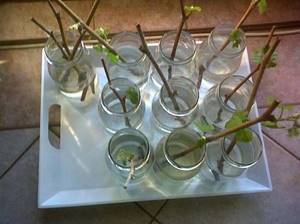
Propagation by cuttings
Cuttings take root quickly, but activities carried out 7 days before planting can speed up this process. The selected place is cleared of weeds and dug up. Then prepare a depression up to 50 cm with drainage covered with a soil cushion. It is created from soil taken from the garden, with the addition of compost and sand.
Attention!
In accordance with the principles of proper pruning of grapes, complex measures should be carried out in the fall, after the end of the sap flow period, or during the period when the parthenocissus has not yet woken up from hibernation. The stump of the trimmed branch should not exceed half a centimeter. In this case, the decorative effect will not suffer.
Layerings
Another breeding option is lash layering, which must be buried in a horizontal position, leaving the tops with healthy buds on the surface of the earth. This method, used in the summer, is recognized as the fastest, with a high percentage of lash survival.
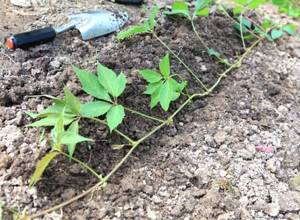
Propagation by seeds
The most favorable option for obtaining a living seedling is from a bush. This will require layering of the second year of life, which is laid and fixed in the ground. The entire period of growth, until the moment of rooting and separation, it will feed from the mother plant.
The main condition for rooting is moist soil, shelter from drying out.
Seeds
Can be propagated by seeds. But this breeding option is considered troublesome and is rarely used. The principle of implementing this method is the process of proper storage, close to natural conditions, and stratification of seeds before germination, lasting 1.5 months.
The optimal procedure mode is 5ºC. The time allotted for the emergence of seedlings does not exceed 30 days. Seed germination is very limited and lasts one year.
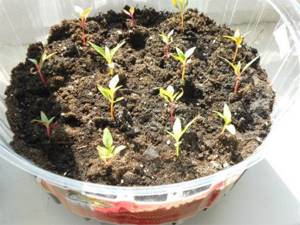
Propagation by seeds
Planting time - before the onset of stable heat or during the period of cool weather. In the second case, stratification is not needed, since the seeds are planted directly into the ground after the onset of significant cold weather. Placing seeds in the soil earlier can lead to germination of the material and death of the sprouts.
Yellow Wall (Yellow Wall, Yellow Wall)
A variety of five-leaf girlish grapes of Polish selection.
Deciduous. The lashes reach 10-15 m in length. It grows moderately quickly, the annual growth is 1-2 m.
Grows on any soil, unpretentious, frost-resistant. Can grow in sun and partial shade. Once a year it is necessary to carry out anti-aging pruning.
It is distinguished by large matte alternately serrated leaves, green in summer and bright yellow in autumn.
It blooms in late May-June and produces blue-black decorative fruits and berries.
Frost resistance zones 4-9.
Used for vertical gardening, feels great as a container plant.
Possible uses of the fruit
Wild grape berries growing in clusters are considered poisonous by many. In fact, this opinion is wrong; they are edible. The fruits are simply very tasteless, as you can see by trying one of them. And poisoning can only occur if you consume an excess amount of berries. However, cases of such poisoning have not yet been recorded: no one voluntarily eats tasteless berries.
Despite the unflattering description of their taste, the fruits of wild grapes have established themselves as a good traditional medicine that helps with certain diseases.
The beneficial properties of these fruits are due to the content of certain substances in them, such as:
- dextrose;
- pectin;
- tartaric, malic and citric acids.
Proponents of traditional medicine advise taking products based on wild grape fruits in the following cases:
- diarrhea;
- disturbances in the gastrointestinal tract;
- deterioration of metabolism;
- increased acidity of gastric juice.
Wild grapes are also useful for improving blood composition and the formation of blood cells.
Attention! The seeds of virgin grapes also bring benefits: oil and vinegar are produced from them.
Graceful vines of wild grapes will enliven any corner, making it cozy and original. This makes it a real boon for landscape design. And the ease of care and unpretentiousness of this plant will save owners from unnecessary hassle. Although inedible berries will not decorate homemade dishes, they will be useful in the fight against disease.
https://7ogorod.ru/plodovye-derevya/devicij-vinograd.html
Variegata
A variety of five-leaf girlish grapes.
Deciduous. The lashes reach 10-15 m in length. It grows moderately quickly, the annual growth is 0.5-1 m.
Grows on any soil, unpretentious. Shade-tolerant, drought-resistant. Once a year it is necessary to carry out anti-aging pruning.
It is distinguished by medium-sized wide leaves, variegated, white with a marbled speckled pattern, less often with green streaks and more or less large spots.
It blooms in May-June and produces very dark red decorative fruits and berries.
Frost resistance zones 4-8.
Used as ground cover and for vertical gardening, it feels great as a container plant.
Why do you need to make supports?
Grapes on a design
Ornamental grapes can be used as a ground cover plant. Without proper control, young shoots quickly spread across the ground and take root. The vine, making its way to the sunlight, will try to climb higher and higher, using other plants. In the shortest possible time, the vines take over a decent area, which is then difficult to clear of thickets. In addition, branches stretching along the ground are exposed to various fungi, molds and pests.
To prevent this from happening (of course, if you do not pursue the goal of creating a grape “carpet”), before planting you need to think about creating a support along which the plant will rise up. In this position, it is enough to simply keep the shoots under control: set the required direction, shape, trim.
Another reason why it is necessary to create supports for maiden vines is the possibility of destruction of the masonry walls of the house or gutters. Maiden grapes have very tenacious tendrils that seek any minimal protrusion to hold the shoot. The branches themselves, growing, become very heavy. If the plant is given support, it will not poke its antennae in search of cracks or tubercles, and you will thereby set the desired direction for growth. The risk of destruction will be minimized.
Star Showers (Star Showers, Starfall)
A variety of five-leaf girlish grapes of American selection
Deciduous. The lashes reach 4-6 m in length. It grows moderately quickly, the annual growth is 0.5-1 m.
Grows on any soil, unpretentious. Shade-tolerant, drought-resistant, frost-resistant. Once a year it is necessary to carry out anti-aging pruning.
It is distinguished by medium-sized variegated alternately jagged white-green and yellow-green leaves.
It blooms in June and produces blue-black decorative fruits and berries.
Frost resistance zones 4-9.
Used for vertical gardening, feels great as a container plant.
What's Contained
The berries of virgin grapes contain a number of fatty acids (palmitic, linoleic, oleic, stearic, etc.), anthocyanins, phytosterols, tricosanol and a number of other chemical compounds. The most dangerous of them are alkaloids.
Despite the fact that virgin grapes are widely used in folk medicine, the stems and leaves are mainly used. Berries are recommended in exceptional cases and in very low concentrations.
